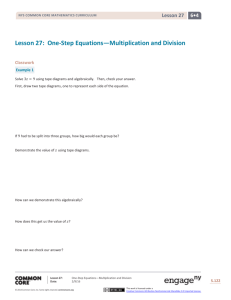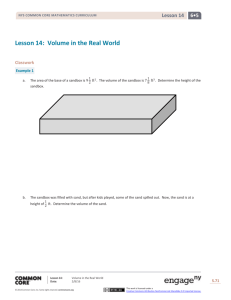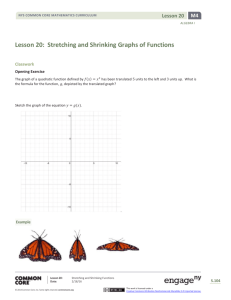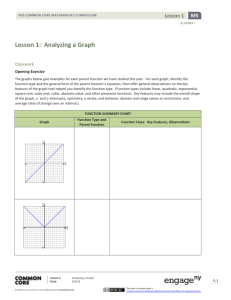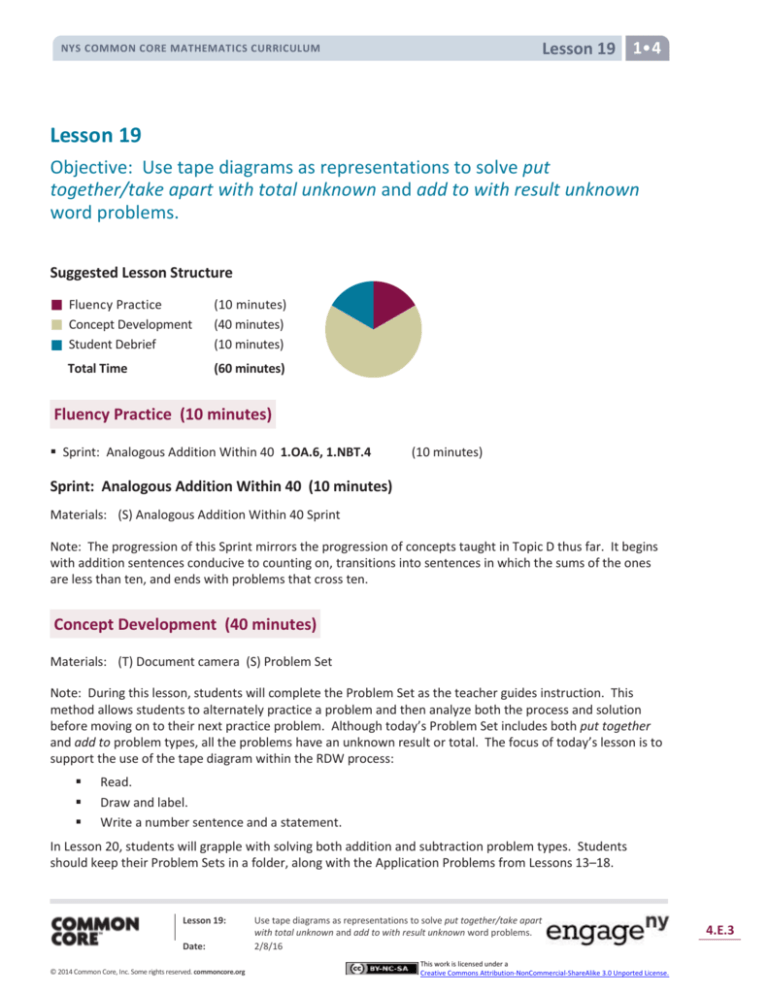
Lesson 19 1•4
NYS COMMON CORE MATHEMATICS CURRICULUM
Lesson 19
Objective: Use tape diagrams as representations to solve put
together/take apart with total unknown and add to with result unknown
word problems.
Suggested Lesson Structure
Fluency Practice
Concept Development
Student Debrief
Total Time
(10 minutes)
(40 minutes)
(10 minutes)
(60 minutes)
Fluency Practice (10 minutes)
Sprint: Analogous Addition Within 40 1.OA.6, 1.NBT.4
(10 minutes)
Sprint: Analogous Addition Within 40 (10 minutes)
Materials: (S) Analogous Addition Within 40 Sprint
Note: The progression of this Sprint mirrors the progression of concepts taught in Topic D thus far. It begins
with addition sentences conducive to counting on, transitions into sentences in which the sums of the ones
are less than ten, and ends with problems that cross ten.
Concept Development (40 minutes)
Materials: (T) Document camera (S) Problem Set
Note: During this lesson, students will complete the Problem Set as the teacher guides instruction. This
method allows students to alternately practice a problem and then analyze both the process and solution
before moving on to their next practice problem. Although today’s Problem Set includes both put together
and add to problem types, all the problems have an unknown result or total. The focus of today’s lesson is to
support the use of the tape diagram within the RDW process:
Read.
Draw and label.
Write a number sentence and a statement.
In Lesson 20, students will grapple with solving both addition and subtraction problem types. Students
should keep their Problem Sets in a folder, along with the Application Problems from Lessons 13–18.
Lesson 19:
Date:
© 2014 Common Core, Inc. Some rights reserved. commoncore.org
Use tape diagrams as representations to solve put together/take apart
with total unknown and add to with result unknown word problems.
2/8/16
This work is licensed under a
Creative Commons Attribution-NonCommercial-ShareAlike 3.0 Unported License.
4.E.3
Lesson 19 1•4
NYS COMMON CORE MATHEMATICS CURRICULUM
Distribute Problem Sets and have students work from their
seats.
T:
(Project Problem 1 on the board.) Let’s read the
problem together.
S/T: Lee saw 6 yellow squashes and 7 pumpkins growing in
his garden. How many vegetables did he see growing
in his garden?
T: On your own, work on solving the problem.
Remember that we always read the problem, draw and
label, and write the number sentence and the
statement that answers the question.
S/T: (Reread the problem as students begin to solve.
Provide a maximum of two minutes for students to
draw and label.)
T: How did you use drawing to make sense of the
problem? Talk with a partner and explain your
drawing.
S: (Provide students 30–45 seconds to share with a
partner.) I drew the 6 squashes in a straight line, and
then 7 pumpkins. I figured out that was 13. (Project
students’ work as they describe their drawings to the
class. Choose student work that most closely
resembles the tape diagram shown to the right.)
T: Look at this student’s work. Where in the drawing can
I find the squashes?
S: (Point to the picture.)
T: (If the 6 squashes are not inside a rectangle or circle to
show the part, include this next sentence.) The label
helps find this part of the drawing. Let’s put a
rectangle around it, so I can keep track of this part
more easily.
T: How many are there?
S: 6.
T: How can I tell quickly? (If the number is not labeled in
the drawing, or is not near the picture, reword the
second question to, “What can I do so I can tell
quickly?”)
S: He wrote 6 next to his picture.
NOTES ON
MULTIPLE MEANS
OF ENGAGEMENT:
Appropriate scaffolds help all students
feel successful. Students may use
translators, interpreters, or sentence
frames to present their solutions or
respond to feedback. Models shared
may include concrete manipulatives.
Problem 1: Lee saw 6 squashes and 7
pumpkins growing in his garden. How many
vegetables did he see growing in his garden?
NOTES ON
MULTIPLE MEANS
OF ENGAGEMENT:
If anticipating students will struggle
with the problems because of the size
of the numbers or the complexity of
the language, follow up with a similar
problem that uses either smaller
quantities or less complex language as
a scaffold step. Be sure to provide at
least one challenging problem to all
students to help them build stamina
and perseverance in problem solving.
Repeat the process asking about the pumpkins, using the same
student work sample.
T:
(Ask a student to read the question from the story again for the class.) How many vegetables are
there?
Lesson 19:
Date:
© 2014 Common Core, Inc. Some rights reserved. commoncore.org
Use tape diagrams as representations to solve put together/take apart
with total unknown and add to with result unknown word problems.
2/8/16
This work is licensed under a
Creative Commons Attribution-NonCommercial-ShareAlike 3.0 Unported License.
4.E.4
Lesson 19 1•4
NYS COMMON CORE MATHEMATICS CURRICULUM
S:
T:
S:
T:
13 vegetables.
So, from here (pointing to one end of the squashes) to
here (pointing to the other end of the pumpkins), we
have 13 vegetables?
Yes!
Let’s show that above our drawing, so we can keep
track. (Draw as shown, so that the bracket, or arms,
represent that everything from one end to the other
has a total of 13. Label with 13.) When we connect
our two parts like this and show the total, we call it a
tape diagram. If you didn’t show this in your drawing,
add it now.
Problem 2: Kiana caught 6 lizards. Her
brother caught 6 snakes. How many reptiles
do they have all together?
Repeat the process for each of the next problems. Use the
questions to move students toward placing rectangles around
each part and labeling with the number inside the part, as well
as using a letter label outside of the shape. Encourage
students to make their rectangles touch, so that they have one
large rectangle for showing the total—the whole.
When discussing Problem 3, after students have had a chance
to solve it, include the following question.
How could using a color change at 10 help you keep
track of the number of soccer balls on the field?
Before moving on to the next problem, ensure that all students
have added labels to each part of their drawings and written the
number sentence and completed the statement.
Choose probing questions appropriate to the successes and
challenges of the class. Encourage early finishers to write their
own word problems on another sheet of paper. They can
write the problem on one side and then write the solution
using a drawing, number sentence, and statement on the
other side.
Problem 3: Anton’s team has 12 soccer balls
on the field and 3 soccer balls in the coach’s
bag. How many soccer balls does Anton’s
team have?
Problem 4: Emi had 13 friends over for
dinner. 4 more friends came over for cake.
How many friends came over to Emi’s
house?
Lesson 19:
Date:
© 2014 Common Core, Inc. Some rights reserved. commoncore.org
Use tape diagrams as representations to solve put together/take apart
with total unknown and add to with result unknown word problems.
2/8/16
This work is licensed under a
Creative Commons Attribution-NonCommercial-ShareAlike 3.0 Unported License.
4.E.5
Lesson 19 1•4
NYS COMMON CORE MATHEMATICS CURRICULUM
Problem 5: 6 adults and 12 children were
swimming in the lake. How many people
were swimming in the lake?
Problem 6: Rose has a vase with 13 flowers.
She puts 7 more flowers in the vase. How
many flowers are in the vase?
Student Debrief (10 minutes)
Lesson Objective: Use tape diagrams as representations
to solve put together/take apart with total unknown and
add to with result unknown word problems.
The Student Debrief is intended to invite reflection and
active processing of the total lesson experience.
Guide students in a conversation to debrief the Problem
Set and process the lesson. Look for misconceptions or
misunderstandings that can be addressed in the Debrief.
Any combination of the questions below may be used to
lead the discussion.
Today, we called our drawings tape diagrams.
Think about the diagrams we draw in science
class. Why might we use the word diagram here?
What are the important parts of our tape
diagram?
Look at Problem 2. What do you notice about the
size of each rectangle around the parts? Why is
that?
Look at Problem 5. How is the tape diagram similar to the one you made for Problem 2? How is it
different? Compare the size of the two rectangles around each part of Problem 5. What do you
notice?
What do you notice about the story problems we completed today? Who created a problem that
puts together two known parts to find an unknown total? Share your story problem with the class.
Lesson 19:
Date:
© 2014 Common Core, Inc. Some rights reserved. commoncore.org
Use tape diagrams as representations to solve put together/take apart
with total unknown and add to with result unknown word problems.
2/8/16
This work is licensed under a
Creative Commons Attribution-NonCommercial-ShareAlike 3.0 Unported License.
4.E.6
Lesson 19 1•4
NYS COMMON CORE MATHEMATICS CURRICULUM
You know your tape diagram has good labels
when you can tell the story by looking at it. Who
can use the tape diagram to tell the soccer ball
story?
How can a tape diagram help us share our
thinking?
Exit Ticket (3 minutes)
After the Student Debrief, instruct students to complete
the Exit Ticket. A review of their work will help with
assessing students’ understanding of the concepts that
were presented in today’s lesson and planning more
effectively for future lessons. The questions may be read
aloud to the students.
Lesson 19:
Date:
© 2014 Common Core, Inc. Some rights reserved. commoncore.org
Use tape diagrams as representations to solve put together/take apart
with total unknown and add to with result unknown word problems.
2/8/16
This work is licensed under a
Creative Commons Attribution-NonCommercial-ShareAlike 3.0 Unported License.
4.E.7
Lesson 19 Sprint 1•4
NYS COMMON CORE MATHEMATICS CURRICULUM
A
Number Correct:
Name
Date
*Write the missing number.
1
6+1=☐
16
6+3=☐
2
16 + 1 = ☐
17
16 + 3 = ☐
3
26 + 1 = ☐
18
26 + 3 = ☐
4
5+2=☐
19
4+5=☐
5
15 + 2 = ☐
20
15 + 4 = ☐
6
25 + 2 = ☐
21
8+2=☐
7
5+3=☐
22
18 + 2 = ☐
8
15 + 3 = ☐
23
28 + 2 = ☐
9
25 + 3 = ☐
24
8+3=☐
10
4+4=☐
25
8 + 13 = ☐
11
14 + 4 = ☐
26
8 + 23 = ☐
12
24 + 4 = ☐
27
8+5=☐
13
5+4=☐
28
8 + 15 = ☐
14
15 + 4 = ☐
29
28 + ☐ = 33
15
25 + 4 = ☐
30
25 + ☐ = 33
Lesson 19:
Date:
© 2014 Common Core, Inc. Some rights reserved. commoncore.org
Use tape diagrams as representations to solve put together/take apart
with total unknown and add to with result unknown word problems.
2/8/16
This work is licensed under a
Creative Commons Attribution-NonCommercial-ShareAlike 3.0 Unported License.
4.E.8
Lesson 19 Sprint 1•4
NYS COMMON CORE MATHEMATICS CURRICULUM
B
Number Correct:
Name
Date
*Write the missing number.
1
5+1=☐
16
6+3=☐
2
15 + 1 = ☐
17
16 + 3 = ☐
3
25 + 1 = ☐
18
26 + 3 = ☐
4
4+2=☐
19
3+5=☐
5
14 + 2 = ☐
20
15 + 3 = ☐
6
24 + 2 = ☐
21
9+1=☐
7
5+3=☐
22
19 + 1 = ☐
8
15 + 3 = ☐
23
29 + 1 = ☐
9
25 + 3 = ☐
24
9+2=☐
10
6+2=☐
25
9 + 12 = ☐
11
16 + 2 = ☐
26
9 + 22 = ☐
12
26 + 2 = ☐
27
9+5=☐
13
4+3=☐
28
9 + 15 = ☐
14
14 + 3 = ☐
29
29 + ☐ = 34
15
24 + 3 = ☐
30
25 + ☐ = 34
Lesson 19:
Date:
© 2014 Common Core, Inc. Some rights reserved. commoncore.org
Use tape diagrams as representations to solve put together/take apart
with total unknown and add to with result unknown word problems.
2/8/16
This work is licensed under a
Creative Commons Attribution-NonCommercial-ShareAlike 3.0 Unported License.
4.E.9
NYS COMMON CORE MATHEMATICS CURRICULUM
Name
Lesson 19 Problem Set 1•4
Date
Read the word problem.
Draw a tape diagram and label.
Write a number sentence and a statement that matches the story.
1. Lee saw 6 squashes and 7 pumpkins growing in his garden. How many vegetables did
he see growing in his garden?
Lee saw __________ vegetables.
2. Kiana caught 6 lizards. Her brother caught 6 snakes. How many reptiles do they
have all together?
Kiana and her brother have __________ reptiles.
3. Anton’s team has 12 soccer balls on the field and 3 soccer balls in the coach’s bag.
How many soccer balls does Anton’s team have?
Anton’s team has __________ soccer balls.
Lesson 19:
Date:
© 2014 Common Core, Inc. Some rights reserved. commoncore.org
Use tape diagrams as representations to solve put together/take apart
with total unknown and add to with result unknown word problems.
2/8/16
This work is licensed under a
Creative Commons Attribution-NonCommercial-ShareAlike 3.0 Unported License.
4.E.10
NYS COMMON CORE MATHEMATICS CURRICULUM
Lesson 19 Problem Set 1•4
4. Emi had 13 friends over for dinner. 4 more friends came over for cake. How many
friends came over to Emi’s house?
There were __________ friends.
5. 6 adults and 12 children were swimming in the lake. How many people were swimming
in the lake?
There were __________ people swimming in the lake.
6. Rose has a vase with 13 flowers. She puts 7 more flowers in the vase. How many
flowers are in the vase?
There are __________ flowers in the vase.
Lesson 19:
Date:
© 2014 Common Core, Inc. Some rights reserved. commoncore.org
Use tape diagrams as representations to solve put together/take apart
with total unknown and add to with result unknown word problems.
2/8/16
This work is licensed under a
Creative Commons Attribution-NonCommercial-ShareAlike 3.0 Unported License.
4.E.11
Lesson 19 Exit Ticket 1•4
NYS COMMON CORE MATHEMATICS CURRICULUM
Name
Date
Read the word problem.
Draw a tape diagram and label.
Write a number sentence and a statement that matches
the story.
1. Peter counted 14 ladybugs in a garden, and Lee counted 6 ladybugs outside of the
garden. How many ladybugs did they count in all?
They counted _____________ ladybugs.
Lesson 19:
Date:
© 2014 Common Core, Inc. Some rights reserved. commoncore.org
Use tape diagrams as representations to solve put together/take apart
with total unknown and add to with result unknown word problems.
2/8/16
This work is licensed under a
Creative Commons Attribution-NonCommercial-ShareAlike 3.0 Unported License.
4.E.12
Lesson 19 Homework 1•4
NYS COMMON CORE MATHEMATICS CURRICULUM
Name
Date
Read the word problem.
Draw a tape diagram and label.
Write a number sentence and a statement that matches
the story.
1. Darnel is playing with his 4 red robots. Ben joins him with 13 blue robots. How
many robots do they have all together?
They have ________ robots.
2. Rose and Emi had a jump rope contest. Rose jumped 14 times, and Emi jumped 6
times. How many times did Rose and Emi jump?
They jumped ________ times.
Lesson 19:
Date:
© 2014 Common Core, Inc. Some rights reserved. commoncore.org
Use tape diagrams as representations to solve put together/take apart
with total unknown and add to with result unknown word problems.
2/8/16
This work is licensed under a
Creative Commons Attribution-NonCommercial-ShareAlike 3.0 Unported License.
4.E.13
NYS COMMON CORE MATHEMATICS CURRICULUM
Lesson 19 Homework 1•4
3. Pedro counted the airplanes taking off and landing at the airport. He saw 7
airplanes take off and 6 airplanes land. How many airplanes did he count
altogether?
Pedro counted _______ airplanes.
4.
Tamra and Willie scored all the points for their team in their basketball game.
Tamra scored 13 points, and Willie scored 5 points. What was their team’s score
for the game?
The team’s score was _______ points.
Lesson 19:
Date:
© 2014 Common Core, Inc. Some rights reserved. commoncore.org
Use tape diagrams as representations to solve put together/take apart
with total unknown and add to with result unknown word problems.
2/8/16
This work is licensed under a
Creative Commons Attribution-NonCommercial-ShareAlike 3.0 Unported License.
4.E.14




